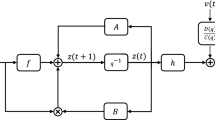Abstract
A bilinear fault detection observer is proposed for a class of continuous time singular bilinear systems subject to unknown input disturbance and fault. By singular value decomposition on the original system, a bilinear fault detection observer is proposed for the decomposed system via an algebraic Riccati equation, and the domain of attraction of the state estimation error is estimated. A design procedure is presented to determine the fault detection threshold. A model of flexible joint robot is used to demonstrate the effectiveness of the proposed method.
Similar content being viewed by others
References
P. M. Frank. Fault diagnosis in dynamic systems using analytical and knowledge based redundancy-a survey of some new results[J]. Automatica, 1990, 26(3): 459–474.
P. M. Frank, X. Ding, Survey of robust residual generation and evaluation methods in observer-based fault detection systems[J]. Journal of Process Control, 1997, 7(6): 403–424.
V. Venkatasubramanian, R. Rengaswamy, K. Yin, et al. A review of process fault detection and diagnosis. Part I: Quantitative model-model based methods[J]. Computers and Chemical Engineering, 2003, 27(2): 293–311.
M. A. Demetriou, M. M. Polycarpou. Incipient fault diagnosis of dynamical systems using online approximators[J]. IEEE Transactions on Automatic Control, 1998, 43(11): 1612–1617.
X. Zhang, M. M. Polycarpou, T. Parisini. A robust detection and isolation scheme for abrupt and incipient faults in nonlinear systems[J], IEEE Transactions on Automatic Control, 2002, 47(4): 576–593.
P. Kabore, H. Wang. Design of fault diagnosis filters and fault-tolerant control for a class of nonlinear systems[J]. IEEE Transactions on Automatic Control, 2001, 46(11): 1805–1810.
M. Staroswiecki, G. Comtet-Varga. Analytical redundancy relations for fault detection and isolationin algebraic dynamic systems[J]. Automatica, 2001, 37(5): 687–699.
X. Hua. Modeling and Control of Bilinear Systems[M]. Shanghai: Press of Chemical Institute of East China, 1990 (in Chinese).
C. Bruni. Bilinear systems: an appealing class of nearly linear systems in theory and applications[J]. IEEE Transactions on Automatic Control, 1974, 19(4): 334–348
M. Kinnaert. Robust fault detection based on observers for bilinear systems[J]. Automatica, 1999, 35(11): 1829–1842.
B. Jiang, J. Wang. Actuator faults diagnosis for a class of bilinear systems with uncertainty[J]. Journal of the Franklin Institute, 2002, 339(3): 361–374.
D. Yu, D. D. Shield. A bilinear fault detection observer[J]. Automatica, 1996, 32(11): 1597–1602.
F. L. Lewis. A survey of linear singular systems[J]. Circuits, Systems and Signal Processing. 1986, 5(1): 3–36.
D. N. Shield. Observer for descriptor systems[J]. International Journal of Control. 1992, 55(1): 240–256.
Q. Zhang, D. Yang. Analysis and Synthesis for Uncertain Descriptor Systems[M]. Shenyang: Press of Northeastern University, 2003(in Chinese).
M. Zasadzinski, E. Magarotto, H. Rafaralahy, et al. Residual generator design for singular bilinear systems subjected to unmeasurable disturbances: an LMI approach[J]. Automatica, 2003, 39(4): 703–713.
D. N. Shield. Observer design and detection for nonlinear descriptor systems[J]. International Journal of Control, 1997, 67(2): 153–168.
Z. Wang, H. Zhang, Z. Wang. Robust capability of disturbance rejection for nonlinear systems satisfying Lipschitz conditions[J]. Journal of Northeastern University (Natural Science), 2004, 25(5): 457–459 (in Chinese).
Author information
Authors and Affiliations
Additional information
This work was supported in part by National Nature Science Foundation of China (No. 60325311, 60534010, 60572070), the Funds for Creative Research Groups of China (No. 60521003) and the Program for Changjiang Scholars and Innovative Research Team in University (No. IRT0421).
Zhanshan WANG was born in Liaoning in 1971. He received the Master Degree in Control Theory and Control Engineering from Fushun Petroleum Institute in 2001. He is now a lecturer in Shenyang Ligong University and pursuing the Ph.D. in Northeastern University. His research interests are in fault diagnosis, fault tolerant control and stability of recurrent neural networks.
Huaguang ZHANG was born in Jilin in 1959. He received the Ph.D. from Southeastern University in 1991. Now he is a professor in Northeastern University. His research interests include fuzzy control, process control, nonlinear control and dynamics of recurrent neural networks.
Rights and permissions
About this article
Cite this article
Wang, Z., Zhang, H. Design of a bilinear fault detection observer for singular bilinear systems. J. Control Theory Appl. 5, 28–36 (2007). https://doi.org/10.1007/s11768-005-5062-3
Received:
Revised:
Issue Date:
DOI: https://doi.org/10.1007/s11768-005-5062-3




